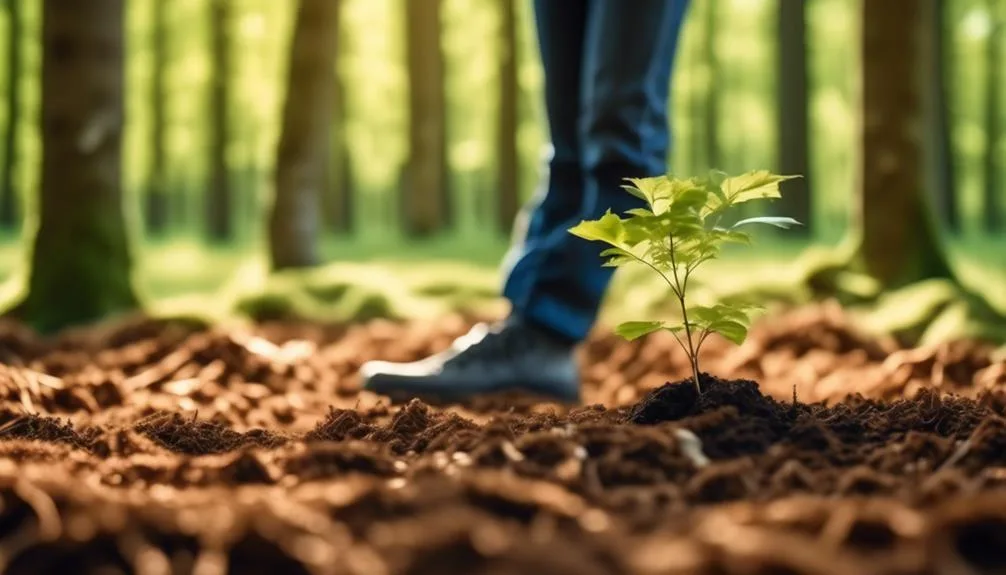Planting beech trees at the right time is crucial for their growth. Whether in the freshness of spring or the crispness of fall, the timing matters. Factors like soil, weather, and planting techniques also impact their health.
Imagine a landscape graced with mature beech trees, their branches swaying in the breeze. To ensure your young beech sapling grows into a stately tree, understanding the best times to plant is essential.
Spring Planting
Now is the perfect time to prepare for spring planting your beech trees, ensuring they've the best start for healthy growth.
When considering tree spacing, it's important to remember that beech trees need ample space to spread their roots and branches. Aim to plant them about 20-30 feet apart to give each tree enough room to thrive without competing for nutrients and sunlight.
Speaking of nutrients, beech trees have moderate nutrient requirements, particularly for nitrogen and phosphorus. When planting, consider adding organic matter to the soil to provide a good foundation of nutrients for the young trees. This will help them establish strong root systems and promote healthy growth.
Fall Planting
Consider preparing your beech trees for fall planting by assessing the soil condition and selecting a suitable location for optimal growth. Before planting, ensure the soil is well-draining and rich in nutrients to support tree growth.
Fall is an ideal time for planting beech trees as the soil is warm, encouraging root establishment before winter. When caring for your trees, ensure they receive adequate water, especially during the first year after planting. Be mindful of the tree's growth rate, which can vary based on environmental factors and care.
Proper pruning and mulching can help maintain the tree's health and encourage steady growth. The cooler temperatures of fall reduce the stress on young trees, allowing them to focus on root development, which is crucial for their long-term health and stability.
Weather Considerations
When planning to plant beech trees, take into account the local weather conditions to ensure the best chance of successful growth. Climate patterns play a crucial role in determining the ideal time for planting beech trees.
Beech trees thrive in temperate climates with well-distributed rainfall throughout the year. Before planting, consider the climate patterns in your area to ensure that the young trees will have the necessary environmental conditions for healthy growth.
Additionally, temperature fluctuations can impact the success of beech tree planting. It's important to monitor the temperature changes in your region to avoid planting during extreme weather conditions, which could stress the young trees.
Soil Preparation
Preparing the soil for planting beech trees involves assessing its composition and making necessary amendments to create an optimal environment for the young trees to thrive.
Start by testing the soil to ensure it's nutrient-rich. Beech trees thrive in well-draining, slightly acidic soil with a pH balance between 6.0 and 6.5.
If the soil pH is too low, it can be raised by incorporating lime, while sulfur can be added to lower the pH if it's too high.
Additionally, organic matter such as compost or well-rotted manure can be mixed into the soil to improve its nutrient content.
Prior to planting, ensure that the soil is loose and free of debris, providing a favorable foundation for the beech tree's roots to establish themselves and flourish.
Planting Techniques
Once you have prepared the soil, it's time to carefully select a suitable location and begin the planting process for your beech trees. When planting, ensure the location offers well-draining soil and receives partial to full sunlight.
Dig a hole twice as wide as the root ball and just as deep. Gently remove the tree from its container, loosen the roots, and place it in the hole. Backfill with soil, tamping down lightly as you go to remove air pockets. Water the tree thoroughly after planting to settle the soil.
Pruning techniques are essential for shaping the young beech tree. Remove any dead or damaged branches and consider shaping the tree to encourage a strong, balanced structure.
Regarding watering frequency, provide consistent moisture, especially during the tree's first year. Water deeply but infrequently to encourage deep root growth. Keep an eye on soil moisture levels, adjusting your watering schedule as needed.
Conclusion
To achieve thriving beech trees, it's crucial to plant them in optimal weather and soil conditions.
With careful soil preparation and planting techniques, your landscape will be adorned with their beauty for years to come.
Happy planting and may your beech trees flourish!

My interest in trees started when I first saw the giant sequoias in Yosemite.
I was a teenager then, and I remember thinking, “I need to learn more about this.”
That moment stuck with me.
A few years later, I went on to study forestry at Michigan Tech.
Since graduating, I’ve worked in a mix of hands-on tree care and community education.
I’ve spent over ten years helping people understand how to plant, maintain, and protect the trees in their neighborhoods.
I don’t see trees as just part of the landscape.
They are living things that make a real difference in our daily lives.
